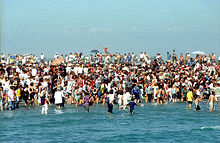Saint Sarah
24 May | |
|---|---|
| Patronage | Romani people |
Saint Sarah, also known as Sara-la-Kâli ("Sara the Black"; Romani: Sara e Kali), is the patron saint of the Romani people. The center of her veneration is Saintes-Maries-de-la-Mer, a place of pilgrimage for Roma in the Camargue, in Southern France. Legend identifies her as the servant of one of the Three Marys, with whom she is supposed to have arrived in the Camargue.[1] Saint Sarah also shares her name with the Hindu goddess Kali who is a popular goddess in northern India from where the Romani people originate. The name "Sara" itself is seen in the appellation of Durga as Kali in the famed text Durgasaptashati.[2]
Accounts



According to various legends, during a
Though the tradition of the Three Marys arriving in France stems from the High Middle Ages, appearing for instance in the 13th century Golden Legend, Saint Sarah makes her first appearance in Vincent Philippon's book The Legend of the Saintes-Maries (1521), where she is portrayed as "a charitable woman that helped people by collecting alms, which led to the popular belief that she was a Gypsy." Subsequently, Sarah was adopted by Romani as their saint.[4]
Another account has Sarah welcoming the Three Marys into Gaul. Franz de Ville (1956) writes:
One of our people who received the first Revelation was Sara the Kali. She was of noble birth and was chief of her tribe on the banks of the
Astarte) and went into the sea to receive benediction there. One day Sara had visions which informed her that the Saints who had been present at the death of Jesus would come, and that she must help them. Sara saw them arrive in a boat. The sea was rough, and the boat threatened to founder. Mary Salome threw her cloak on the waves and, using it as a raft, Sarah floated towards the Saints and helped them reach land by praying.[5]
Pilgrimage
The day of the pilgrimage honouring Sarah is May 24; her statue is carried down to the sea on this day to re-enact her arrival in France.
Some authors have drawn parallels between the ceremonies of the pilgrimage and the worship of the Hindu goddess Kali (a form of Durga), subsequently identifying the two.[6] Ronald Lee (2001) states:
If we compare the ceremonies with those performed in France at the shrine of Sainte Sara (called Sara e Kali in Romani), we become aware that the worship of Kali/Durga/Sara has been transferred to a Christian figure... in France, to a non-existent "sainte" called Sara, who is actually part of the Kali/Durga/Sara worship among certain groups in India.[7]
The name "Sara" itself is seen in the appellation of Durga as Kali in the famed text Durgasaptashati.[2]
In popular culture
Some authors,
- In The Rozabal Line, author Ashwin Sanghi puts forward that Sara-la-Kali refers to the three Hindu goddesses – Saraswati, Lakshmi, and Kali – the goddesses of Knowledge, Wealth and Power – symbolizing the trinity of female power.
- In Paulo Coelho's novel The Witch of Portobello, St. Sarah is mentioned several times.
- Alistair MacLean's 1970 thriller, Caravan to Vaccarès is set during the pilgrimage to Saintes-Maries-de-la-Mer.
- Czon the Swedish artist did a portrait of Sara La Kali outside the church in "Saintes Maries de la Mer" 2018.[15]
- The statue of Saint Sarah makes an appearance in Tony Gatlif's 1993 film Latcho Drom (Safe Journey) where it is carried to the sea, and her landing is re-enacted.
- In Korkoro, also a Tony Gatlif film, the Romani often pray to Saint Sarah with intense fervor.
References
- ^ Bart McDowell, Gypsies: Wanderers of the World, pp. 38–57.
- ^ a b Lee, R. (2002) The Romani goddess Kali Sara
- ^ Michal Droit, Carmague, p. 19.
- ^ "Myth 101 – Saint Sarah – OPUS Archives and Research Center". 15 February 2011.
- ^ Franz de Ville, Traditions of the Roma in Belgium.
- ^ Isabel Fonseca, Bury Me Standing: The Gypsies and Their Journey, pp. 106–107.
- ^ Ronald Lee, "The Rom-Vlach Gypsies and the Kris-Romani", p. 210.
- ^ Margaret Starbird, The Woman with the Alabaster Jar: Mary Magdalen and the Holy Grail, Bear & Company, 1993.
- Fida Hassnain, A Search for the Historical Jesus (Gateway Books, 1994).
- ISBN 1-86204-472-4.
- ^ Eron Manusov, Ahavah's Dream (PublishAmerica Inc, 2005).
- ^ Elizabeth Cunningham, Bright Dark Madonna, Monkfish Book Publishing Company, 2009; Red-Robed Priestess, Monkfish Book Publishing Company, 2011.
- ^ The Real Da Vinci Code, Channel Four Television, 3 February 2005.
- ^ Behind The Mysteries: Unlocking Da Vinci's Code – The Full Story, National Geographic Channel, 19 December 2004.
- ^ "Min vän: Romernas Skyddshelgon Sara La Kali, Sara e Kali, Svarta Sara, Saint Sarah – i Saintes Maries-de la Mar". admin-czon.blogspot.se. 2018.
Sources
- de Ville, Franz, Traditions of the Roma in Belgium, Brussels, 1956.
- Droit, Michel, Carmague. Ernest and Adair Heimann (trans.). London: George Allen and Unwin, 1963.
- Fonseca, Isabel, Bury Me Standing: The Gypsies and Their Journey. New York: Knopf, 1996.
- Kinsley, David R. Hindu Goddesses: Visions of the Divine Feminine in the Hindu Religious Tradition.' Berkeley: University of California Press, 1988.
- Lee, Ronald, "The Rom-Vlach Gypsies and the Kris-Romani", in: Walter Weyrauch (ed.), Gypsy Law: Romani Legal Traditions and Culture, Berkeley: University of California Press, 2001.
- McDowell, Bart, Gypsies: Wanderers of the World', Washington: National Geographic Society, 1970.
- Weyrauch, Walter, "Oral Legal Traditions of Gypsies", in: Walter Weyrauch (ed.), Gypsy Law: Romani Legal Traditions and Culture, Berkeley: University of California Press, 2001.
External links
- Jarmila Balazova, Religion among the Roma
